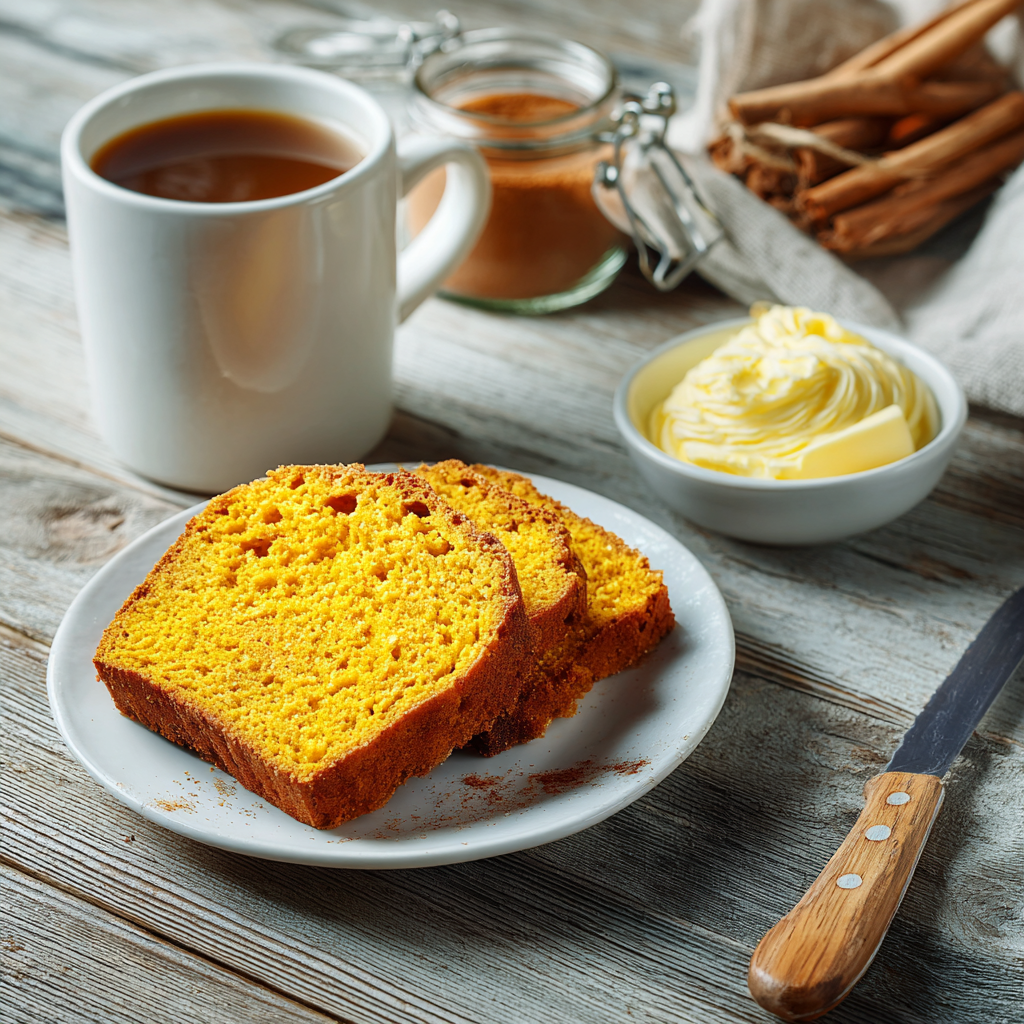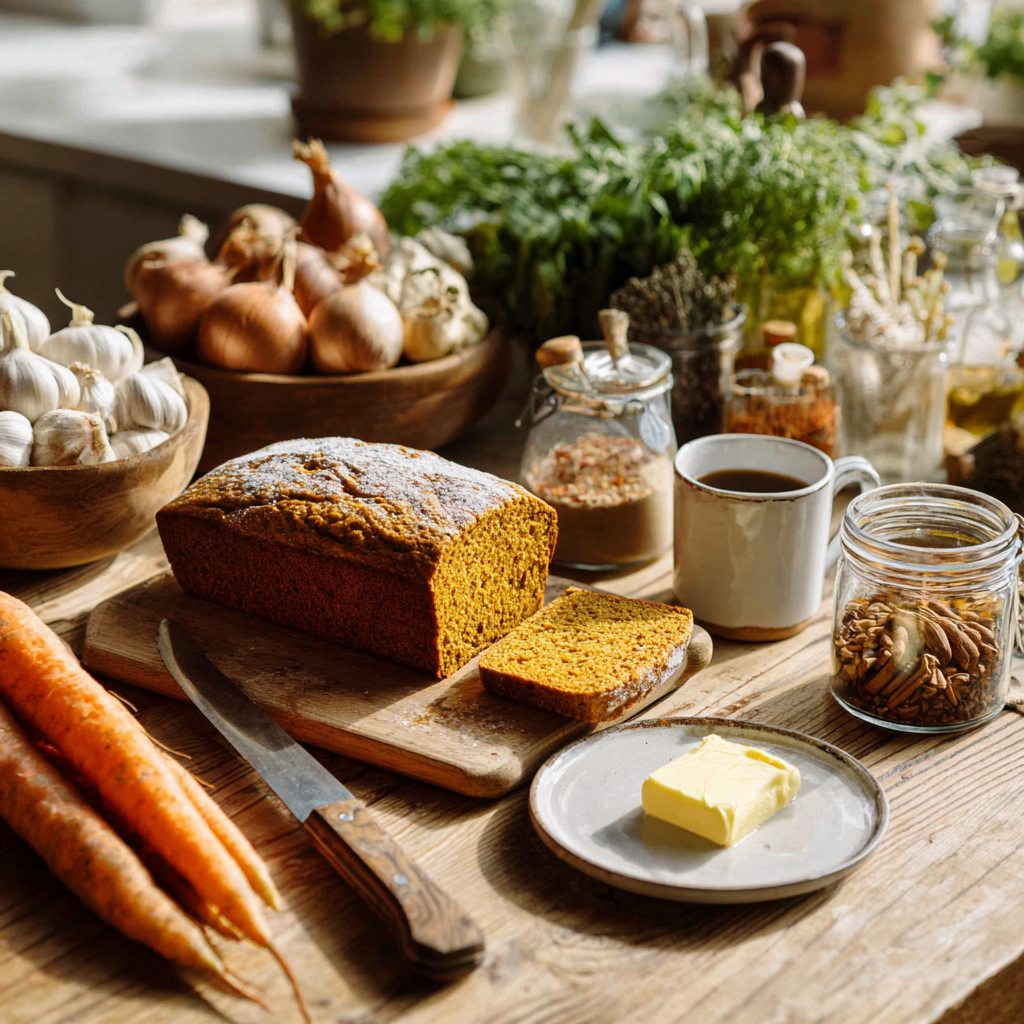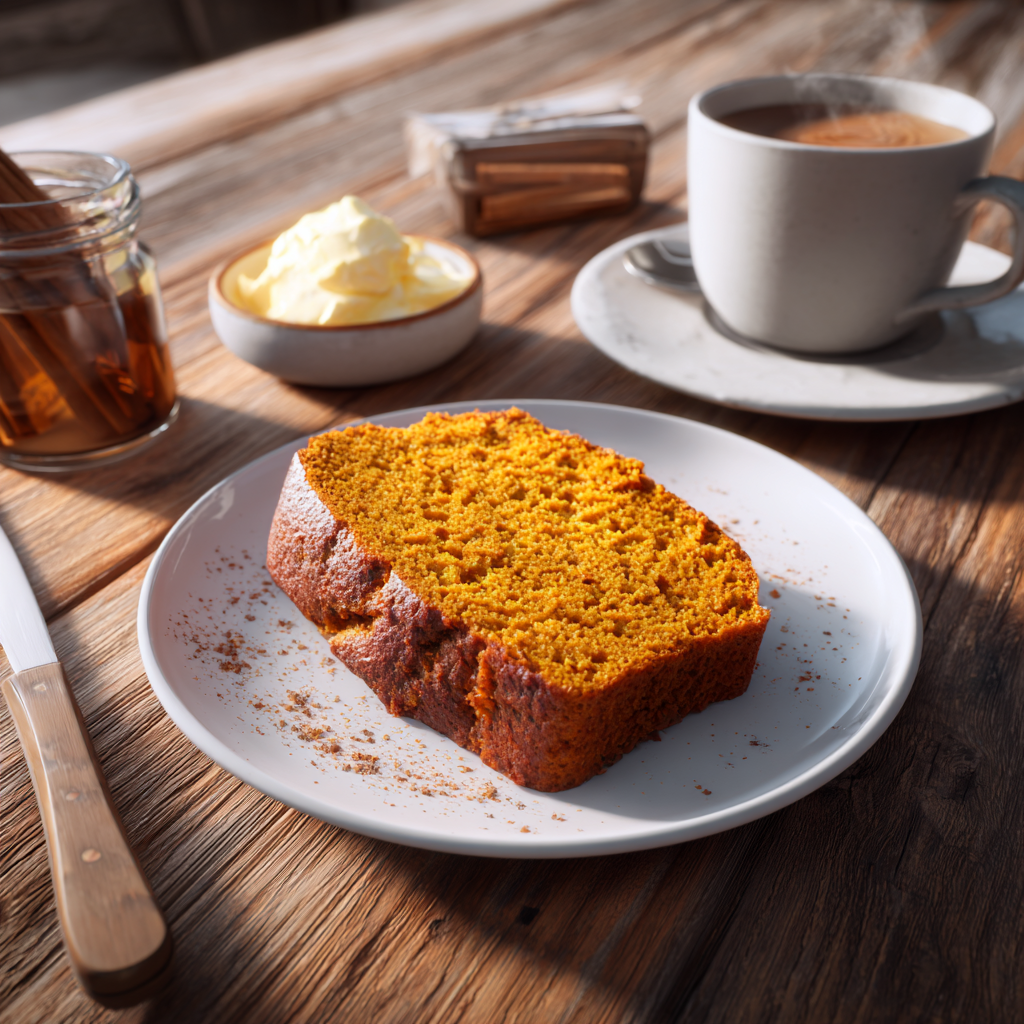
Introduction
The smell of pumpkin spice always takes me back to my grandma’s kitchen. She had this way of making fall feel magical with just one loaf of bread. Now, years later, I find myself doing the same thing. Baking has become my happy place, especially when the leaves start to change and the air turns crisp. My go-to? Libby’s pumpkin bread recipe. It’s simple, foolproof, and brings that cozy autumn feeling right into my home.
I can’t count how many times I’ve made this bread over the years. Friends and family ask for it at every gathering, and it’s become a staple in my kitchen. But here’s the best part: you don’t need to be an expert baker to nail it. This article will walk you through everything you need to know. From answering questions like What are the ingredients in Libby’s pumpkin bread mix? to sharing tips on how to make your loaf taste even better, I’ve got you covered.
Why Choose Libby’s Pumpkin Bread?
Let’s talk about why Libby’s canned pumpkin puree is my top pick. Not all pumpkin purees are created equal, and trust me, I’ve tried them all. Libby’s stands out because it’s smooth, consistent, and packed with flavor. The rich, earthy taste pairs perfectly with warm spices like cinnamon and nutmeg. It’s no wonder so many bakers call it the secret behind the classic pumpkin bread.
One reason I love using Libby’s is its reliability. Every can delivers the same texture and taste, so I never have to worry about lumpy batter or bland results. Plus, it mixes beautifully with other ingredients, giving you that soft, moist pumpkin bread everyone craves. If you’re new to baking, this consistency makes all the difference.
Another perk? It’s versatile. You can stick to the easy pumpkin bread recipe on the back of the can or get creative by adding extras like chocolate chips, nuts, or dried fruit. Here are a few ideas to take your bread to the next level:
- Spices: Add extra cinnamon or a pinch of cloves for deeper flavor.
- Toppings: Sprinkle coarse sugar on top before baking for a sweet crunch.
- Mix-ins: Fold in white chocolate chips or chopped pecans for texture.
Now, let’s address some common questions people ask about this recipe. First up: What are the ingredients in Libby’s pumpkin bread mix? While there isn’t a pre-made mix, the recipe calls for pantry staples like flour, sugar, eggs, oil, and, of course, Libby’s pumpkin puree. It’s straightforward, which makes it perfect for beginners.
Another question I hear often is, What can I add to pumpkin bread to make it taste better? The key is balance. Start with high-quality ingredients, like Libny’s puree, and build from there. A teaspoon of vanilla extract adds warmth, while a splash of orange zest brightens the flavors. And don’t skip the spices—they’re what give pumpkin bread its signature cozy vibe.
Sometimes, though, things don’t go as planned. For example, Why did my pumpkin bread turn out gummy? This usually happens if the batter is overmixed or underbaked. To avoid this, stir gently until just combined and check for doneness with a toothpick. Insert it into the center—if it comes out clean, your bread is ready.
Lastly, let’s tackle a baking debate: Why use oil instead of butter in pumpkin bread? Oil keeps the bread moist without weighing it down. Butter can make baked goods dense, but oil creates a lighter texture. That said, if you prefer the taste of butter, you can swap half the oil with melted butter. Just know that oil is the classic choice for good reason.
Baking pumpkin bread is more than just following a recipe—it’s about creating something comforting and delicious. Whether you’re a seasoned baker or trying this for the first time, Libby’s pumpkin bread is a great place to start. With its foolproof formula and endless possibilities, it’s no wonder it’s become a fall favorite for so many.
Keep reading to learn step-by-step instructions and pro tips that’ll help you bake the perfect loaf every time.
Step-by-Step Instructions for Libby’s Pumpkin Bread Recipe
Alright, let’s dive right into the nitty-gritty of making this magical loaf. Now that we’ve covered why Libby’s pumpkin bread is so special, it’s time to get our hands dirty—literally. Here’s the thing: baking pumpkin bread isn’t rocket science. With a little patience and some good vibes, you’ll have a loaf ready to impress even your pickiest relatives.
Ingredients & Substitutions
So, what exactly goes into this fall classic? If you’re wondering What are the ingredients in Libby’s pumpkin bread mix?, hold up—I need to clarify something. There isn’t an official pre-made mix (though I wish there were because I’d stockpile it). Instead, the recipe calls for pantry staples that most of us already have lying around. Here’s the lineup:
- All-purpose flour
- Sugar (white or brown works)
- Baking soda
- Salt
- Cinnamon, nutmeg, cloves—you know, the usual suspects
- Eggs
- Libby’s canned pumpkin puree
- Vegetable oil
- Water
Funny enough, the simplicity of these ingredients is what makes this recipe shine. It’s like they’re all just waiting for their moment to come together. But what if you’re vegan, gluten-free, or just feeling experimental? No worries. You can swap out several things without losing the charm of the bread.
For example, replace the eggs with flax eggs (1 tablespoon ground flaxseed + 3 tablespoons water per egg) if you’re going egg-free. Gluten-free flour blends work beautifully too—I’ve tried them when my cousin visited last Thanksgiving, and no one noticed the difference. Oh, and here’s a fun tip: if you’re not a fan of vegetable oil, melted butter adds a richer flavor, though I personally stick with oil for that light, airy texture.
By the way, if you’re looking for more bread inspiration, check out this Jimmy John’s bread recipe. It’s a totally different vibe but equally satisfying.
Mixing and Baking Tips
Okay, now onto the process. Mixing batter might seem straightforward, but trust me, technique matters. One of the biggest questions I hear is Why did my pumpkin bread turn out gummy? Let me break it down for you. Overmixing is often the culprit. Stirring too much develops gluten in the flour, which leads to dense, chewy bread. So go easy on yourself—just mix until everything comes together.
Another pro tip? Make sure your oven is properly preheated before popping your loaf in. Ovens can be sneaky about heating evenly, so invest in an oven thermometer if you’re unsure. And don’t rush the bake time—it’s better to err on the side of caution than pull it out too early. A toothpick inserted into the center should come out clean or with a few moist crumbs clinging to it. That’s how you know it’s done.
Here’s where people sometimes trip up: adjusting the temperature. Most recipes call for 350°F, but depending on your oven, you may need to tweak it slightly. If the top browns too quickly, tent it loosely with foil to prevent burning. On the flip side, if the edges are browning while the middle still wobbles, lower the temp by 25 degrees and extend the baking time. Patience pays off here.
And speaking of moisture, remember the age-old debate about Why use oil instead of butter in pumpkin bread? Oil keeps the crumb soft and tender, whereas butter tends to weigh things down. Don’t get me wrong—I love butter as much as the next person, but in this case, oil really is king. That said, feel free to experiment. Sometimes half butter, half oil gives you the best of both worlds.
Enhancing Your Pumpkin Bread
Now, let’s talk upgrades. Sure, the basic recipe is amazing, but adding a few extras can take your pumpkin bread from “yum” to “wow.” Ever wondered What can I add to pumpkin bread to make it taste better? The possibilities are endless. Personally, I’m a sucker for mixing in chocolate chips—it’s like giving the bread a hug from the inside. White chocolate pairs surprisingly well with pumpkin spice, but semi-sweet or dark chocolate works too.
Nuts are another fantastic option. Pecans and walnuts bring crunch and depth, while dried cranberries add a tangy sweetness that balances the spices. Speaking of cranberries, if you haven’t tried the Ocean Spray cranberry bread recipe, it’s worth a shot. The combo of tart cranberries and warm spices is seriously addictive.
For those who like bold flavors, consider tossing in some crystallized ginger or a splash of bourbon. Yes, bourbon. Just a tablespoon will do wonders for enhancing the overall aroma and taste. Or, if you’re feeling fancy, try swirling in a ribbon of cream cheese frosting before baking. Trust me, it’s life-changing.
Let’s not forget toppings either. Sprinkling coarse sugar on top gives the crust a delightful sparkle and crunch. For a more rustic look, press sliced almonds or pumpkin seeds into the batter before baking. And hey, if you want to channel your inner artist, drizzle a simple glaze made from powdered sugar and milk once the bread has cooled. It’s simple yet oh-so-effective.
Side note: if you’re curious about other bread recipes, the Better Homes and Gardens banana bread recipe is a solid choice. It’s got a similar cozy vibe but swaps pumpkin for bananas. Perfect for when you’re craving variety.
Finally, let’s chat about spicing things up. While cinnamon, nutmeg, and cloves are classics, don’t shy away from experimenting. Cardamom adds a floral note, while allspice brings warmth. Freshly grated nutmeg is also a game-changer—it’s stronger and more aromatic than the pre-ground stuff. And if you’re feeling adventurous, throw in a pinch of black pepper. Sounds weird, I know, but it amplifies the spices in the background.
Oh, and one last idea: ever heard of squaw bread? It’s a lesser-known gem packed with molasses and raisins. Check out this squaw bread recipe if you’re intrigued. It’s hearty, wholesome, and pairs beautifully with pumpkin spice season.
At the end of the day, baking pumpkin bread is all about making it your own. Whether you stick to the basics or go wild with mix-ins, the result will always carry that comforting essence of fall. So grab your apron, crank up some tunes, and let the magic happen.
Troubleshooting Common Issues with Libby’s Pumpkin Bread Recipe
Baking is kind of like a science experiment. Sometimes things go perfectly, and other times? Well, let’s just say it’s not always picture-perfect. But here’s the good news: most pumpkin bread problems are fixable. Let me walk you through some common hiccups I’ve encountered over the years—and how to avoid them.
First up, **underbaked centers**. This one happens more often than you’d think. You pull the loaf out of the oven, it looks golden brown on top, but when you slice into it—oh no, it’s still gooey in the middle. Usually, this means your oven temperature was off or you didn’t bake it long enough. Here’s a trick: stick a toothpick or cake tester into the thickest part of the loaf. If it comes out clean (or with just a few crumbs), you’re golden. If not, pop it back in for another 5–10 minutes. Oh, and don’t forget to preheat your oven properly—it makes a world of difference.
On the flip side, we’ve got **dry loaves**, which are equally heartbreaking. Dry pumpkin bread is usually the result of overbaking or using too much flour. Measuring your ingredients accurately is key here. I can’t stress this enough: scoop your flour lightly into the measuring cup and level it off with a knife. Don’t pack it down like you’re trying to win a sandcastle contest. That extra flour will soak up all the moisture, leaving you with a crumbly mess. Trust me—I learned this the hard way after ruining an entire batch last year.
Now, let’s circle back to that gummy texture issue. You know, the one where the bread feels dense and almost sticky inside? Funny enough, this usually has less to do with the pumpkin puree and more to do with how you mix the batter. Overmixing activates gluten in the flour, making the bread tough instead of tender. So resist the urge to keep stirring. Mix until everything is *just* combined—it’s okay if there are a few lumps. Another culprit? Underbaking. Yep, sometimes it’s both underbaked and overmixed. Double whammy.
By the way, ingredient choices matter too. For instance, if you’re wondering Why use oil instead of butter in pumpkin bread?, remember that oil creates a lighter, airier texture. Butter adds richness but can weigh the bread down. If you’re set on using butter, try swapping half the oil with melted butter. It’s a compromise that works pretty well. And please, whatever you do, don’t skimp on the spices—they’re what give pumpkin bread its soul.
Here’s something else I’ve noticed: people get nervous about tweaking recipes. But honestly, baking should be fun, not stressful. If you accidentally add a smidge too much spice or sugar, don’t panic. Chances are, it’ll still taste great. Just take notes so you can adjust next time. Baking is as much about learning as it is about eating!
Frequently Asked Questions About Libby’s Pumpkin Bread Recipe
Let’s tackle some burning questions I hear all the time from fellow bakers. Whether you’re a newbie or a seasoned pro, these answers will help you nail your next loaf.
- Q: What are the ingredients in Libby’s pumpkin bread mix?
A: Technically, there isn’t a pre-made mix, but the classic recipe calls for pantry staples like flour, sugar, eggs, vegetable oil, water, baking soda, salt, and, of course, Libby’s canned pumpkin puree. It’s simple yet incredibly versatile. - Q: What can I add to pumpkin bread to make it taste better?
A: The sky’s the limit! Try tossing in chocolate chips, chopped nuts, or dried cranberries for texture. A splash of vanilla extract or orange zest brightens the flavor, while spices like cardamom or freshly grated nutmeg deepen it. Experiment and find your favorite combo. - Q: Why did my pumpkin bread turn out gummy?
A: Gumminess usually stems from overmixing the batter or underbaking the loaf. Stir gently until just combined, and always check for doneness with a toothpick. If the center is still wet, bake it a little longer. - Q: Why use oil instead of butter in pumpkin bread?
A: Oil keeps the bread moist and gives it a light, tender crumb. Butter can make baked goods denser, though it does add richness. If you want the best of both worlds, use half oil and half melted butter. - Q: Can I freeze pumpkin bread?
A: Absolutely! Wrap the cooled loaf tightly in plastic wrap, then foil, and freeze for up to three months. Thaw at room temperature before serving. It’s perfect for holiday prep or gifting. - Q: How do I store leftover pumpkin bread?
A: Keep it in an airtight container at room temperature for up to three days. For longer storage, refrigerate it or freeze slices individually for easy snacking later. - Q: Can I reduce the sugar in the recipe?
A: Yes, but proceed with caution. Reducing sugar too much can affect the bread’s texture and sweetness. Start by cutting it by 25% and see how you like the results. - Q: Is Libby’s pumpkin puree the same as pumpkin pie filling?
A: No! Pumpkin pie filling contains added sugar and spices, while puree is plain and unsweetened. Always grab the puree for baking unless the recipe specifies otherwise. - Q: Can I make this recipe gluten-free?
A: Definitely. Swap the all-purpose flour for a gluten-free flour blend, and ensure your other ingredients are certified gluten-free. The texture might vary slightly, but it’ll still be delicious. - Q: What can I use instead of eggs in pumpkin bread?
A: Flax eggs (1 tablespoon ground flaxseed + 3 tablespoons water per egg) work beautifully. Applesauce or mashed banana can also substitute, though they may alter the flavor slightly.
If you’re looking for even more inspiration, head over to our bread recipes collection. From classic loaves to creative twists, there’s something for everyone.
Final Thoughts on Libby’s Pumpkin Bread Recipe
You know what I love most about baking pumpkin bread? It’s not just about the end result—it’s the process. The smell of cinnamon wafting through the house, the anticipation of slicing into a warm loaf, the joy of sharing it with loved ones. These moments remind me why I fell in love with baking in the first place.
So go ahead, give this recipe a shot. Maybe start with the basics, then branch out and experiment. Add a swirl of caramel sauce or sprinkle some sea salt on top. Make it yours. And hey, if it doesn’t turn out exactly as planned, that’s okay. Every misstep teaches you something new.
Enjoy those cozy fall vibes, whether you’re curled up with a book or hosting friends for coffee. Because at the end of the day, nothing says “home” quite like a slice of homemade pumpkin bread. Happy baking! 🍂

Libby's Pumpkin Bread Recipe
Ingredients
Equipment
Method
- Preheat your oven to 350°F (175°C).
- In a large bowl, mix the flour, sugar, baking soda, salt, and spices until well combined.
- In another bowl, whisk together the eggs, pumpkin puree, oil, and water.
- Pour the wet ingredients into the dry ingredients and stir until just combined. Avoid overmixing.
- Pour the batter into a greased loaf pan.
- Bake in the preheated oven for 60-70 minutes, or until a toothpick inserted in the center comes out clean.
- Allow to cool in the pan for 10 minutes before transferring to a wire rack to cool completely.


